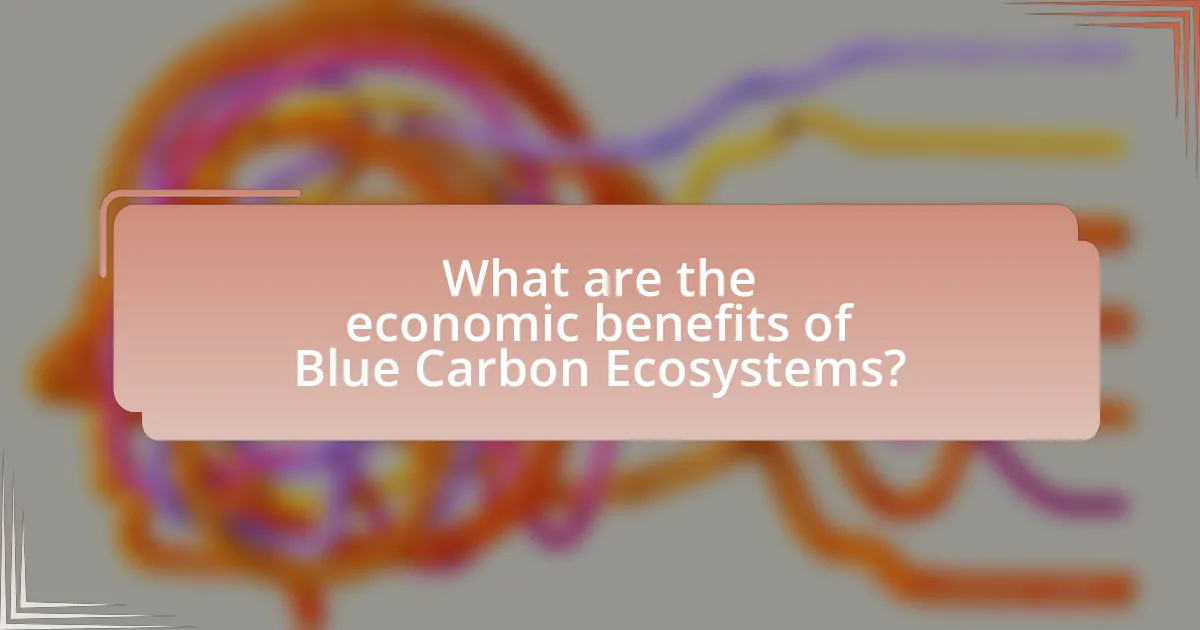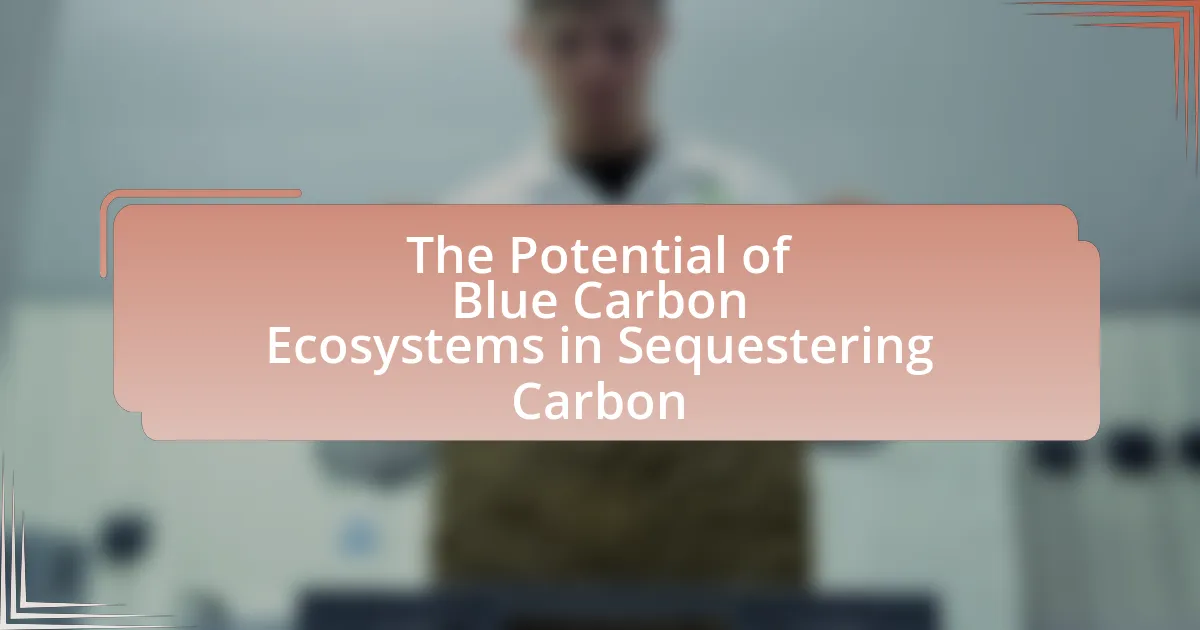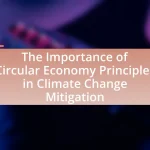Blue Carbon Ecosystems, which include mangroves, salt marshes, and seagrasses, play a crucial role in sequestering carbon dioxide from the atmosphere, capturing it at rates significantly higher than terrestrial forests. These ecosystems not only mitigate climate change by reducing greenhouse gas concentrations but also provide essential habitats for biodiversity and protect coastal areas from erosion and flooding. The article explores the mechanisms of carbon sequestration in these ecosystems, their importance for climate change mitigation, the challenges they face, and the economic benefits they offer. It also discusses effective conservation strategies and the role of local communities in preserving these vital habitats.

What are Blue Carbon Ecosystems?
Blue Carbon Ecosystems are coastal and marine environments, such as mangroves, salt marshes, and seagrasses, that capture and store carbon dioxide from the atmosphere. These ecosystems are significant because they sequester carbon at rates much higher than terrestrial forests, with mangroves, for instance, storing up to four times more carbon per hectare than tropical forests. The importance of Blue Carbon Ecosystems lies in their ability to mitigate climate change by reducing greenhouse gas concentrations, while also providing critical habitat for biodiversity and protecting coastal areas from erosion and flooding.
How do Blue Carbon Ecosystems contribute to carbon sequestration?
Blue Carbon Ecosystems, which include mangroves, salt marshes, and seagrasses, contribute to carbon sequestration by capturing and storing carbon dioxide from the atmosphere in their biomass and sediments. These ecosystems are highly efficient at sequestering carbon; for instance, mangroves can store up to four times more carbon per hectare than tropical forests. The anaerobic conditions in the waterlogged soils of these ecosystems slow down the decomposition of organic matter, leading to long-term carbon storage. Studies indicate that coastal wetlands can sequester carbon at rates of 0.5 to 2.0 gigatons per year globally, highlighting their significant role in mitigating climate change.
What types of ecosystems are classified as Blue Carbon ecosystems?
Blue Carbon ecosystems are primarily classified into three types: mangroves, salt marshes, and seagrasses. These ecosystems are recognized for their ability to sequester carbon dioxide from the atmosphere and store it in their biomass and sediments. Research indicates that mangroves can store up to four times more carbon per hectare than tropical forests, while salt marshes and seagrasses also play significant roles in carbon storage, contributing to climate change mitigation efforts.
How do these ecosystems function in the carbon cycle?
Blue carbon ecosystems, such as mangroves, salt marshes, and seagrasses, function in the carbon cycle by sequestering carbon dioxide from the atmosphere and storing it in their biomass and sediments. These ecosystems capture carbon through photosynthesis, where plants convert CO2 into organic matter, contributing to carbon storage in their roots, stems, and leaves.
Research indicates that blue carbon ecosystems can sequester carbon at rates up to 10 times greater than terrestrial forests, with mangroves alone storing an estimated 1.5 billion tons of carbon annually. Additionally, the sediments in these ecosystems can store carbon for centuries, effectively removing it from the atmosphere and mitigating climate change.
Why are Blue Carbon Ecosystems important for climate change mitigation?
Blue Carbon Ecosystems are crucial for climate change mitigation because they sequester significant amounts of carbon dioxide from the atmosphere. These ecosystems, including mangroves, salt marshes, and seagrasses, can store up to four times more carbon per hectare than terrestrial forests. Research indicates that coastal habitats can sequester carbon at rates of 1.5 to 3.5 billion tons annually, which plays a vital role in reducing greenhouse gas concentrations. By protecting and restoring these ecosystems, we can enhance their carbon storage capacity, thereby contributing to global efforts to combat climate change.
What role do Blue Carbon ecosystems play in reducing greenhouse gas emissions?
Blue Carbon ecosystems, such as mangroves, salt marshes, and seagrasses, play a crucial role in reducing greenhouse gas emissions by sequestering carbon dioxide from the atmosphere. These ecosystems can store carbon at rates up to five times greater than terrestrial forests, effectively capturing and storing carbon in their biomass and sediments. For instance, a study published in “Nature Climate Change” by M. N. Bouillon et al. (2008) highlights that coastal ecosystems can sequester approximately 1.5 billion tons of carbon annually, significantly mitigating climate change impacts. By preserving and restoring Blue Carbon ecosystems, we can enhance their capacity to sequester carbon, thereby contributing to global efforts in reducing greenhouse gas emissions.
How do Blue Carbon ecosystems enhance biodiversity?
Blue Carbon ecosystems enhance biodiversity by providing critical habitats for a wide range of marine and terrestrial species. These ecosystems, such as mangroves, salt marshes, and seagrasses, support diverse food webs and serve as nurseries for fish and other aquatic organisms. For instance, mangroves can host over 1,000 species of plants and animals, while seagrass beds are known to support more than 1,000 species of marine life, including commercially important fish. The structural complexity of these habitats offers shelter and breeding grounds, which are essential for maintaining healthy populations of various species. Additionally, Blue Carbon ecosystems contribute to nutrient cycling and water filtration, further promoting ecosystem health and resilience, which in turn supports greater biodiversity.

What are the challenges facing Blue Carbon Ecosystems?
Blue Carbon Ecosystems face several significant challenges, including habitat degradation, climate change, and insufficient policy support. Habitat degradation occurs due to coastal development, pollution, and unsustainable fishing practices, which threaten the integrity of mangroves, salt marshes, and seagrasses. Climate change exacerbates these issues by causing sea-level rise and altering salinity levels, further stressing these ecosystems. Additionally, the lack of comprehensive policies and funding for conservation and restoration efforts limits the effectiveness of Blue Carbon initiatives. According to the Intergovernmental Panel on Climate Change, protecting and restoring these ecosystems is crucial for enhancing their carbon sequestration potential and mitigating climate change impacts.
What threats do Blue Carbon ecosystems encounter?
Blue Carbon ecosystems encounter threats such as coastal development, pollution, climate change, and invasive species. Coastal development, including urbanization and infrastructure projects, leads to habitat loss and degradation of mangroves, salt marshes, and seagrasses, which are crucial for carbon sequestration. Pollution from agricultural runoff and industrial discharges negatively impacts water quality and ecosystem health, further compromising these habitats. Climate change poses a significant threat through rising sea levels and increased storm intensity, which can erode coastal ecosystems and disrupt their ability to store carbon. Additionally, invasive species can outcompete native flora, altering ecosystem dynamics and reducing the effectiveness of Blue Carbon habitats in sequestering carbon.
How does coastal development impact Blue Carbon ecosystems?
Coastal development negatively impacts Blue Carbon ecosystems by leading to habitat loss, degradation, and reduced carbon sequestration capacity. Activities such as urbanization, infrastructure construction, and agriculture disrupt coastal wetlands like mangroves, salt marshes, and seagrasses, which are crucial for storing carbon. For instance, a study published in “Nature Climate Change” by M. N. Bouillon et al. (2008) indicates that coastal wetlands can sequester carbon at rates up to 10 times greater than terrestrial forests. The destruction of these ecosystems due to coastal development not only releases stored carbon but also diminishes their ability to capture future carbon emissions, exacerbating climate change.
What are the effects of climate change on these ecosystems?
Climate change negatively impacts blue carbon ecosystems by altering their ability to sequester carbon and maintain biodiversity. Rising sea levels inundate coastal habitats such as mangroves, salt marshes, and seagrasses, leading to habitat loss and reduced carbon storage capacity. Additionally, increased ocean temperatures and acidification affect the health of these ecosystems, diminishing their productivity and resilience. For instance, studies indicate that mangroves can lose up to 30% of their biomass due to climate-induced stressors, which directly correlates with a decrease in carbon sequestration potential. Furthermore, the disruption of these ecosystems can lead to increased greenhouse gas emissions, exacerbating climate change effects.
How can we protect and restore Blue Carbon ecosystems?
To protect and restore Blue Carbon ecosystems, it is essential to implement conservation strategies, sustainable management practices, and restoration projects. Conservation strategies include establishing protected areas to safeguard mangroves, salt marshes, and seagrasses, which are critical for carbon sequestration. Sustainable management practices involve regulating coastal development, reducing pollution, and promoting responsible fishing to maintain ecosystem health. Restoration projects can include replanting native vegetation and rehabilitating degraded areas, which have been shown to enhance carbon storage capacity. For instance, a study published in “Nature Climate Change” by M. N. Bouillon et al. highlights that restoring mangrove forests can sequester up to 1,000 metric tons of carbon per hectare over 20 years, demonstrating the effectiveness of these approaches in enhancing Blue Carbon ecosystems.
What strategies are effective for the conservation of Blue Carbon ecosystems?
Effective strategies for the conservation of Blue Carbon ecosystems include the restoration of mangroves, salt marshes, and seagrasses, as well as the implementation of sustainable management practices. Restoration efforts have been shown to enhance carbon sequestration, with studies indicating that restored mangroves can sequester up to four times more carbon than degraded areas. Sustainable management practices, such as regulated fishing and coastal development, help maintain the ecological integrity of these ecosystems, ensuring their continued ability to capture and store carbon. Additionally, legal protections and community engagement are crucial for the successful conservation of these habitats, as they foster local stewardship and compliance with conservation efforts.
How can restoration projects enhance carbon sequestration in these ecosystems?
Restoration projects can enhance carbon sequestration in blue carbon ecosystems by rehabilitating coastal habitats such as mangroves, salt marshes, and seagrasses, which are known for their high carbon storage capacity. These ecosystems can sequester carbon at rates up to 10 times greater than terrestrial forests, as evidenced by studies showing that mangroves can store over 1,000 tons of carbon per hectare over a 20-year period. By restoring these habitats, projects not only increase the biomass available for carbon storage but also improve soil carbon stocks through the accumulation of organic matter. Furthermore, restoration efforts can enhance ecosystem resilience, allowing these habitats to better withstand climate change impacts, thereby maintaining their carbon sequestration potential over time.

What are the economic benefits of Blue Carbon Ecosystems?
Blue Carbon Ecosystems provide significant economic benefits through carbon sequestration, coastal protection, and enhanced fisheries. These ecosystems, such as mangroves, salt marshes, and seagrasses, can sequester carbon at rates up to 10 times higher than terrestrial forests, leading to potential revenue from carbon credits in carbon trading markets. Additionally, they protect coastlines from erosion and storm surges, reducing infrastructure costs and insurance claims. The restoration and conservation of these ecosystems can also boost local fisheries by providing critical habitats, which can increase fish stocks and support local economies. Studies indicate that every dollar invested in coastal restoration can yield up to $4 in economic returns, highlighting the financial viability of preserving Blue Carbon Ecosystems.
How do Blue Carbon ecosystems provide economic value?
Blue Carbon ecosystems provide economic value primarily through carbon sequestration, which can be monetized via carbon credits. These ecosystems, such as mangroves, salt marshes, and seagrasses, sequester significant amounts of carbon dioxide, with estimates suggesting that they can store up to 1.5 billion tons of carbon annually. This carbon storage can be translated into financial benefits through carbon trading markets, where companies and governments purchase carbon credits to offset their emissions. Additionally, Blue Carbon ecosystems support fisheries and tourism, contributing to local economies; for instance, healthy mangrove forests can enhance fish populations, leading to increased catches for local fishermen. Studies indicate that investing in the restoration and conservation of these ecosystems can yield returns of up to $30 for every dollar spent, highlighting their economic potential.
What industries can benefit from the preservation of Blue Carbon ecosystems?
The industries that can benefit from the preservation of Blue Carbon ecosystems include fisheries, tourism, and carbon trading. Fisheries benefit from healthy coastal ecosystems that support fish populations and biodiversity, leading to sustainable catches. The tourism industry gains from the aesthetic and recreational value of pristine coastal environments, attracting visitors and generating revenue. Additionally, carbon trading markets can capitalize on the carbon sequestration capabilities of Blue Carbon ecosystems, allowing companies to offset emissions and meet regulatory requirements. These benefits are supported by studies indicating that mangroves, salt marshes, and seagrasses can sequester significant amounts of carbon, making their preservation economically advantageous across these sectors.
How can Blue Carbon credits be utilized in carbon markets?
Blue Carbon credits can be utilized in carbon markets by providing a mechanism for the trading of carbon offsets generated from the preservation and restoration of coastal and marine ecosystems, such as mangroves, salt marshes, and seagrasses. These ecosystems sequester significant amounts of carbon dioxide, with estimates suggesting that mangroves alone can store up to 1,000 metric tons of carbon per hectare over their lifespan. By quantifying the carbon sequestration potential of these ecosystems, Blue Carbon credits can be issued and sold to companies and governments seeking to offset their carbon emissions, thereby creating a financial incentive for the conservation and restoration of these vital habitats. This approach not only contributes to climate change mitigation but also supports biodiversity and enhances coastal resilience.
What are the best practices for engaging communities in Blue Carbon initiatives?
The best practices for engaging communities in Blue Carbon initiatives include fostering local participation, providing education and awareness, and ensuring equitable benefit-sharing. Local participation is crucial as it empowers communities to take ownership of conservation efforts, leading to more sustainable outcomes. Education and awareness initiatives help communities understand the importance of Blue Carbon ecosystems, such as mangroves and seagrasses, in climate change mitigation and biodiversity preservation. Equitable benefit-sharing ensures that communities receive tangible benefits from conservation efforts, which can motivate ongoing engagement and support. For instance, projects that have successfully integrated these practices, like the Blue Carbon Initiative, have demonstrated increased community involvement and improved conservation results.
How can local communities be involved in the conservation of Blue Carbon ecosystems?
Local communities can be involved in the conservation of Blue Carbon ecosystems through participatory management practices, education, and sustainable livelihood initiatives. Engaging local populations in the stewardship of coastal habitats, such as mangroves and salt marshes, allows them to contribute to conservation efforts while benefiting from ecosystem services. For instance, community-led restoration projects have been shown to enhance biodiversity and carbon sequestration, as evidenced by a study published in “Nature Climate Change,” which highlighted that local involvement can increase the success rate of restoration efforts by up to 50%. Additionally, providing training and resources for sustainable fishing and tourism can create economic incentives for communities to protect these vital ecosystems, thereby aligning conservation goals with local economic interests.
What educational programs can raise awareness about Blue Carbon ecosystems?
Educational programs that can raise awareness about Blue Carbon ecosystems include community workshops, school curricula focused on marine biology and ecology, and online courses offered by environmental organizations. These programs educate participants on the importance of coastal ecosystems like mangroves, salt marshes, and seagrasses in carbon sequestration. For instance, the Blue Carbon Initiative provides resources and training to enhance understanding of these ecosystems’ roles in climate mitigation. Additionally, programs like the Ocean Conservancy’s educational outreach efforts aim to engage the public and policymakers in recognizing the value of Blue Carbon habitats.
What practical steps can individuals take to support Blue Carbon ecosystems?
Individuals can support Blue Carbon ecosystems by participating in conservation efforts, such as volunteering for coastal restoration projects and supporting organizations focused on protecting mangroves, salt marshes, and seagrasses. Engaging in local initiatives helps restore and maintain these vital ecosystems, which are known to sequester significant amounts of carbon—mangroves, for instance, can store up to four times more carbon per hectare than tropical forests. Additionally, individuals can advocate for policies that protect Blue Carbon habitats and reduce carbon emissions, thereby contributing to the overall health of these ecosystems. By making sustainable choices, such as reducing plastic use and promoting responsible seafood consumption, individuals can further minimize their impact on coastal environments, supporting the resilience of Blue Carbon ecosystems.


